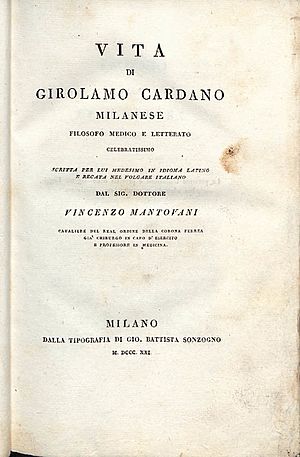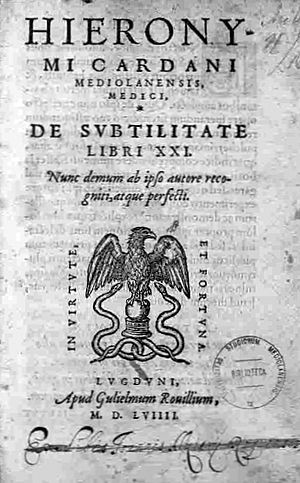Gerolamo Cardano facts for kids
Quick facts for kids
Gerolamo Cardano
|
|
|---|---|
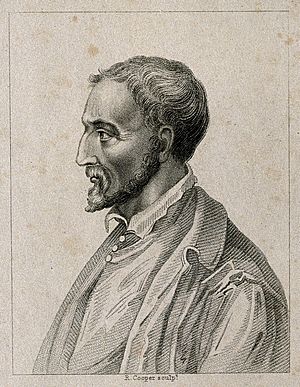
17th-century portrait engraving of Cardano
|
|
| Born | 24 September 1501 |
| Died | 21 September 1576 (aged 74) |
| Nationality | Italian |
| Alma mater | University of Pavia |
| Known for | Cardano–Tartaglia formula First systematic use of negative numbers in Europe |
| Scientific career | |
| Fields | Science, mathematics, philosophy, and literature |
| Notable students | Lodovico Ferrari |
| Influences | Archimedes, Muḥammad ibn Mūsā al-Khwārizmī, Leonardo Fibonacci |
| Influenced | Blaise Pascal, François Viète, Pierre de Fermat, Isaac Newton, Gottfried Wilhelm von Leibniz, Maria Gaetana Agnesi, Joseph-Louis Lagrange, Carl Friedrich Gauss |
Gerolamo Cardano (Italian: [dʒeˈrɔːlamo karˈdaːno]; also Girolamo or Geronimo; French: Jérôme Cardan; Latin: Hieronymus Cardanus; 24 September 1501– 21 September 1576) was an Italian polymath, whose interests and proficiencies ranged through those of mathematician, physician, biologist, physicist, chemist, astrologer, astronomer, philosopher, writer, and gambler. He was one of the most influential mathematicians of the Renaissance, and was one of the key figures in the foundation of probability and the earliest introducer of the binomial coefficients and the binomial theorem in the Western world. He wrote more than 200 works on science.
Cardano partially invented and described several mechanical devices including the combination lock, the gimbal consisting of three concentric rings allowing a supported compass or gyroscope to rotate freely, and the Cardan shaft with universal joints, which allows the transmission of rotary motion at various angles and is used in vehicles to this day. He made significant contributions to hypocycloids, published in De proportionibus, in 1570. The generating circles of these hypocycloids were later named Cardano circles or cardanic circles and were used for the construction of the first high-speed printing presses.
Today, he is well known for his achievements in algebra. In his 1545 book Ars Magna, he made the first systematic use of negative numbers in Europe, published with attribution the solutions of other mathematicians for the cubic and quartic equations, and acknowledged the existence of imaginary numbers.
Contents
Early life and education
Cardano was born on 24 September 1501 in Pavia, Lombardy, the illegitimate child of Fazio Cardano, a mathematically gifted jurist, lawyer, and close friend of Leonardo da Vinci. In his autobiography, Cardano wrote that his mother, Chiara Micheri, had taken "various abortive medicines" to terminate the pregnancy; he said: "I was taken by violent means from my mother; I was almost dead." She was in labour for three days. Shortly before his birth, his mother had to move from Milan to Pavia to escape the Plague; her three other children died from the disease.
After a depressing childhood, with frequent illnesses, and the rough upbringing by his overbearing father, in 1520, Cardano entered the University of Pavia against the wish of his father, who wanted his son to undertake studies of law, but Girolamo felt more attracted to philosophy and science. During the Italian War of 1521–1526, however, the authorities in Pavia were forced to close the university in 1524. Cardano resumed his studies at the University of Padua, where he graduated with a doctorate in medicine in 1525. His eccentric and confrontational style did not earn him many friends and he had a difficult time finding work after his studies had ended. In 1525, Cardano repeatedly applied to the College of Physicians in Milan, but was not admitted owing to his combative reputation and illegitimate birth. However, he was consulted by many members of the College of Physicians, because of his irrefutable intelligence.
Early career as a physician
Cardano wanted to practice medicine in a large, rich city like Milan, but he was denied a license to practice, so he settled for the town of Piove di Sacco, where he practiced without a license. There, he married Lucia Banderini in 1531. Before her death in 1546, they had three children, Giovanni Battista (1534), Chiara (1537) and Aldo Urbano (1543). Cardano later wrote that those were the happiest days of his life.
With the help of a few noblemen, Cardano obtained a teaching position in mathematics in Milan. Having finally received his medical license, he practiced mathematics and medicine simultaneously, treating a few influential patients in the process. Because of this, he became one of the most sought-after doctors in Milan. In fact, by 1536, he was able to quit his teaching position, although he was still interested in mathematics. His notability in the medical field was such that the aristocracy tried to lure him out of Milan. Cardano later wrote that he turned down offers from the kings of Denmark and France, and the Queen of Scotland.
Mathematics

Gerolamo Cardano was the first European mathematician to make systematic use of negative numbers. He published with attribution the solution of Scipione del Ferro to the cubic equation and the solution of Cardano's student Lodovico Ferrari to the quartic equation in his 1545 book Ars Magna, an influential work on algebra. The solution to one particular case of the cubic equation  (in modern notation) had been communicated to him in 1539 by Niccolò Fontana Tartaglia (who later claimed that Cardano had sworn not to reveal it, and engaged Cardano in a decade-long dispute) in the form of a poem, but del Ferro's solution predated Tartaglia's. In his exposition, he acknowledged the existence of what are now called imaginary numbers, although he did not understand their properties, described for the first time by his Italian contemporary Rafael Bombelli. In Opus novum de proportionibus he introduced the binomial coefficients and the binomial theorem.
(in modern notation) had been communicated to him in 1539 by Niccolò Fontana Tartaglia (who later claimed that Cardano had sworn not to reveal it, and engaged Cardano in a decade-long dispute) in the form of a poem, but del Ferro's solution predated Tartaglia's. In his exposition, he acknowledged the existence of what are now called imaginary numbers, although he did not understand their properties, described for the first time by his Italian contemporary Rafael Bombelli. In Opus novum de proportionibus he introduced the binomial coefficients and the binomial theorem.
Cardano was notoriously short of money and kept himself solvent by being an accomplished gambler and chess player. His book about games of chance, Liber de ludo aleae ("Book on Games of Chance"), written around 1564, but not published until 1663, contains the first systematic treatment of probability, as well as a section on effective cheating methods. He used the game of throwing dice to understand the basic concepts of probability. He demonstrated the efficacy of defining odds as the ratio of favourable to unfavourable outcomes (which implies that the probability of an event is given by the ratio of favourable outcomes to the total number of possible outcomes). He was also aware of the multiplication rule for independent events but was not certain about what values should be multiplied.
Other contributions
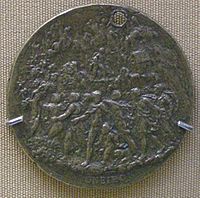
Cardano's work with hypocycloids led him to Cardan's Movement or Cardan Gear mechanism, in which a pair of gears with the smaller being one-half the size of the larger gear is used converting rotational motion to linear motion with greater efficiency and precision than a Scotch yoke, for example. He is also credited with the invention of the Cardan suspension or gimbal.
Cardano made several contributions to hydrodynamics and held that perpetual motion is impossible, except in celestial bodies. He published two encyclopedias of natural science which contain a wide variety of inventions, facts, and occult superstitions. He also introduced the Cardan grille, a cryptographic writing tool, in 1550.
Significantly, in the history of education of the deaf, he said that deaf people were capable of using their minds, argued for the importance of teaching them, and was one of the first to state that deaf people could learn to read and write without learning how to speak first. He was familiar with a report by Rudolph Agricola about a deaf mute who had learned to write.
Cardano's medical writings included: a commentary on Mundinus' anatomy and of Galen's medicine, along with the treaties Delle cause, dei segni e dei luoghi delle malattie, Picciola terapeutica, Degli abusi dei medici and Delle orine, libro quattro.
Cardano has been credited with the invention of the so-called Cardano's Rings, also called Chinese Rings, but it is very probable that they predate Cardano. The universal joint, sometimes called Cardan joint, was not described by Cardano.
De Subtilitate (1550)
Later years and death
In 1553 Cardano traveled to Scotland to treat the Archbishop of St Andrews who suffered of a disease that had left him speechless and was thought incurable. The treatment was a success and the diplomat Thomas Randolph recorded that "merry tales" about Cardano's methods were still current in Edinburgh in 1562. Cardano wrote that the Archbishop had been short of breath for ten years, and after the cure was effected by his assistant, he was paid 1,400 gold crowns.
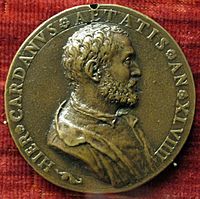
Two of Cardano's children — Giovanni Battista and Aldo Urbano — came to ignoble ends. Giovanni Battista, Cardano's eldest and favorite son was arrested in 1560 for having poisoned his wife, after he had discovered that their three children were not his. Giovanni was put to trial and, when Cardano could not pay the restitution demanded by the victim's family, was sentenced to death and executed. Cardano's other son Aldo Urbano was a gambler, who stole money from his father, and so Gerolamo disinherited him in 1569.
Cardano moved from Pavia to Bologna, in part because he believed that the decision to execute his son was influenced by Gerolamo's battles with the academic establishment in Pavia, and his colleagues' jealousy at his scientific achievements. He obtained a position as professor of medicine at the University of Bologna.
Cardano was arrested by the Inquisition in 1570 after an accusation of heresy by the Inquisitor of Como, who targeted Cardano's De rerum varietate (1557). The inquisitors complained about Cardano's writings on astrology. In his 1543 book De Supplemento Almanach, a commentary on the astrological work Tetrabiblos by Ptolemy, Cardano had also published a horoscope of Jesus. Cardano was imprisoned for several months and lost his professorship in Bologna. He abjured and was freed, probably with help from powerful churchmen in Rome. All his non-medical works were prohibited and placed on the Index.
He moved to Rome, where he received a lifetime annuity from Pope Gregory XIII (after first having been rejected by Pope Pius V, who died in 1572) and finished his autobiography. He was accepted in the Royal College of Physicians, and as well as practising medicine he continued his philosophical studies until his death in 1576.
Works
- De malo recentiorum medicorum medendi usu libellus, Hieronymus Scotus, Venice, 1536 (on medicine).
- Practica arithmetice et mensurandi singularis (on mathematics), Io. Antoninus Castellioneus/Bernadino Caluscho, Milan, 1539.
- De Consolatione, Libri tres, Hieronymus Scotus, Venice, 1542.
- Translation into English by T. Bedingfield (1573).
- Libelli duo: De Supplemento Almanach; De Restitutione temporum et motuum coelestium; Item Geniturae LXVII insignes casibus et fortuna, cum expositione, Iohan. Petreius, Norimbergae, 1543.
- De Sapientia, Libri quinque, Iohan. Petreius, Norimbergae, 1544 (with De Consolatione reprint and De Libris Propriis, book I).
- De Immortalitate animorum, Henric Petreius, Nuremberg 1544/Sebastianus Gryphius, Lyons, 1545.
- Contradicentium medicorum (on medicine), Hieronymus Scotus, Venetijs, 1545.
- Artis magnae, sive de regulis algebraicis (on algebra: also known as Ars magna), Iohan. Petreius, Nuremberg, 1545.
- Translation into English by D. Witmer (1968).
- Della Natura de Principii e Regole Musicale, ca 1546 (on music theory: in Italian): posthumously published.
- De Subtilitate rerum (on natural phenomena), Johann Petreius, Nuremberg, 1550 .
- Translation into English by J.M. Forrester (2013).
- Metoposcopia libris tredecim, et octingentis faciei humanae eiconibus complexa (on physiognomy), written 1550 (published posthumously by Thomas Jolly, Paris (Lutetiae Parisiorum), 1658).
- In Cl. Ptolemaei Pelusiensis IIII, De Astrorum judiciis... libros commentaria: cum eiusdem De Genituris libro, Henrichus Petri, Basle, 1554.
- Geniturarum Exemplar (De Genituris liber, separate printing), Theobaldus Paganus, Lyons, 1555.
- Ars Curandi Parva (written c. 1556).
- De Libris propriis (about the books he has written, and his successes in medical work), Gulielmus Rouillius, Leiden, 1557.
- De Rerum varietate, Libri XVII (on natural phenomena); (Revised edition), Matthaeus Vincentius, Avignon 1558. Also Basle, Henricus Petri, 1559.
- Actio prima in calumniatorem (reply to J.C. Scaliger), 1557.
- De Utilitate ex adversis capienda, Libri IIII (on the uses of adversity), Henrich Petri, Basle, 1561.
- Theonoston, seu De Tranquilitate, 1561. (Opera, Vol. II).
- Somniorum synesiorum omnis generis insomnia explicantes, Libri IIII (Book of Dreams: with other writings), Henricus Petri, Basle 1562.
- Neronis encomium (a life of Nero), Basle, 1562.
- Translation into English by A. Paratico (2012).
- De Providentia ex anni constitutione, Alexander Benaccius, Bononiae, 1563.
- De Methodo medendi, Paris, In Aedibus Rouillii, 1565.
- De Causis, signis ac locis morborum, Liber unus, Alexander Benatius, Bononiae, 1569.
- Commentarii in Hippocratis Coi Prognostica, Opus Divinum; Commentarii De Aere, aquis et locis opus, Henric Petrina Officina, Basel, 1568/1570.
- Opus novum, De Proportionibus numerorum, motuum, ponderum, sonorum, aliarumque rerum mensurandarum. Item de aliza regula, Henric Petrina, Basel, 1570.
- Opus novum, cunctis De Sanitate tuenda, Libri quattuor, Sebastian HenricPetri, Basle, 1569.
- De Vita propria, 1576 (autobiography).
- Translation into English by J. Stoner (2002).
- Liber De Ludo aleae ("On Casting the Die"; on probability): posthumously published.
- Translation into English by S.H. Gould (1961).
- Proxeneta, seu De Prudentia Civili (posthumously published: Paulus Marceau, Geneva, 1630).
Collected Works
A chronological key to this edition is supplied by M. Fierz.
- Hieronymi Cardani Mediolanensis Opera Omnia, cura Carolii Sponii (Lugduni, Ioannis Antonii Huguetan and Marci Antonii Ravaud, 1663) (10 volumes, Latin):
- Volume 1: Philologica, Logica, Moralia (Internet Archive; another at Google; another at Google)
- Volume 2: Moralia Quaedam et Physica (Google)
- Volume 3: Physica (Google)
- Volume 4: Arithmetica, Geometrica, Musica (Google)
- Volume 5: Astronomica, Astrologica, Onirocritica (Internet Archive; another at Google)
- Volume 6: Medicinalium I (Google)
- Volume 7: Medicinalium II (Google)
- Volume 8: Medicinalium III (Google)
- Volume 9: Medicinalium IV (Google)
- Volume 10: Opuscula Miscellanea (Google)
See also
 In Spanish: Gerolamo Cardano para niños
In Spanish: Gerolamo Cardano para niños
- Blow book, an early form of art or magic trick initially uncovered by Gerolamo Cardano
- Negative numbers, the core of Cardano's major contributions to science and mathematics


